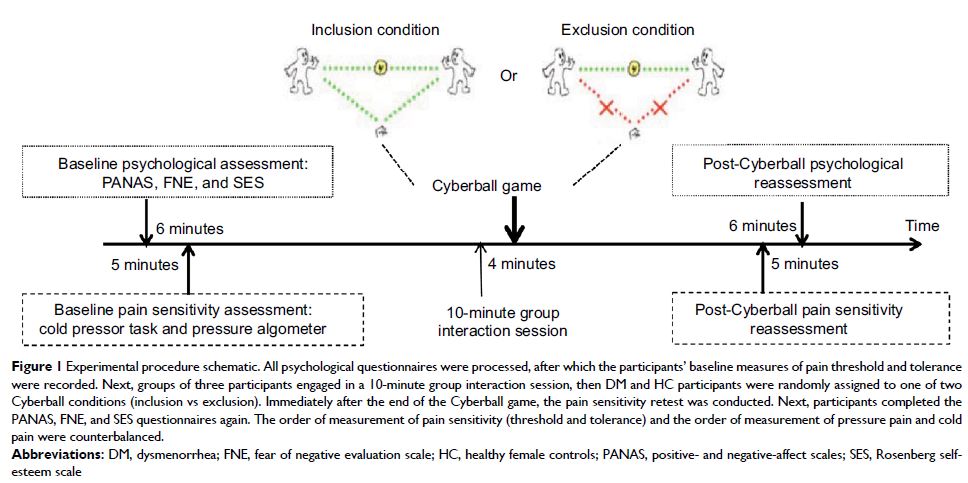108605
论文已发表
注册即可获取德孚的最新动态
IF 收录期刊
- 3.4 Breast Cancer (Dove Med Press)
- 3.2 Clin Epidemiol
- 2.6 Cancer Manag Res
- 2.9 Infect Drug Resist
- 3.7 Clin Interv Aging
- 5.1 Drug Des Dev Ther
- 3.1 Int J Chronic Obstr
- 6.6 Int J Nanomed
- 2.6 Int J Women's Health
- 2.9 Neuropsych Dis Treat
- 2.8 OncoTargets Ther
- 2.0 Patient Prefer Adher
- 2.2 Ther Clin Risk Manag
- 2.5 J Pain Res
- 3.0 Diabet Metab Synd Ob
- 3.2 Psychol Res Behav Ma
- 3.4 Nat Sci Sleep
- 1.8 Pharmgenomics Pers Med
- 2.0 Risk Manag Healthc Policy
- 4.1 J Inflamm Res
- 2.0 Int J Gen Med
- 3.4 J Hepatocell Carcinoma
- 3.0 J Asthma Allergy
- 2.2 Clin Cosmet Investig Dermatol
- 2.4 J Multidiscip Healthc

痛经妇女因社会排斥而导致的身体疼痛感中断的现象
Authors Yu W, Guan F, Fu L, Long C, Yang L
Received 17 March 2018
Accepted for publication 15 May 2018
Published 3 August 2018 Volume 2018:11 Pages 1469—1477
DOI https://doi.org/10.2147/JPR.S168516
Checked for plagiarism Yes
Review by Single-blind
Peer reviewers approved by Dr Amy Norman
Peer reviewer comments 3
Editor who approved publication: Dr E Alfonso Romero-Sandoval
Purpose: Dysmenorrhea (DM), which involves both acute and chronic pain, is
associated with abnormalities in pain modulation. Previous studies have shown
that social pain relies on some of the same neural regions that process
physical pain, highlighting a possible physical–social pain overlap. However,
evidence suggesting that social pain modulates the sensitivity to physical pain
remains controversial. The present study aimed to assess the effects of social
pain manipulation on sensitivity to physical pain in DM sufferers and healthy
female controls (HC).
Materials and
methods: Fifty-nine otherwise healthy
patients with DM and 55 HC matched for age, education, calendar age, and
gynecological age were randomly assigned to inclusion or exclusion conditions
of Cyberball, a virtual ball tossing game used to induce social pain (social
exclusion). Pain threshold and pain tolerance in response to nociceptive
pressure and cold stimuli were assessed before and after the study condition.
Results: In response to cold stimulation, pain threshold and tolerance
significantly reduced in DM compared to HC participants in the inclusion condition,
indicating increased pain sensitivity in DM group. However, exclusion increased
the pain threshold and tolerance compared to inclusion in DM but decreased pain
threshold and tolerance in HC. Neither inclusion nor exclusion altered pressure
pain sensitivity in DM, but, after social exclusion, DM participants were more
fearful of being evaluated unfavorably. No significant differences were
observed in self-esteem scores between DM and HC after both inclusion and
exclusion.
Conclusion: We observed altered pain sensation in DM participants in response
to social pain manipulation, suggesting that DM not only impacts menstruation
but also modulates the perception of pain more generally, especially its
affective processes. The present study suggests that the effect of social pain
on pain sensation and certain psychometric properties depends on previous pain
experience, implicating a reciprocal influence of social and physical pain
processes.
Keywords: dysmenorrhea, Cyberball, pain modulation, pain sensitivity,
physical pain, social pain, social exclusion
